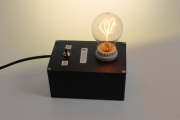
|
SCE-1032020
Electricity & Magnetism Light Bulb Demo.$162.60
. Using the "Electricity & Magnetism Light Bulb Demo", you will demonstrate to your students the relationship between electricity and magnetism . The link between electricity and magnetism finds its legendary roots back to Hans Christian Orsted when he supposedly found that electric current affected his compasses during a student lecture. That piece of scientific history may be one of exaggerated legend, but the marriage of electricity with magnetism has been widely known for over a century, later to be given a full mathematical explanation by Lord Kelvin and James Clerk Maxwell. The concept of electron movement causing the production of an ensuing magnetic field is a fundamental model used in describing electromagnets, generators, transformers, and electric motors. Students can witness the magnetic fields produced by electron movement using compass deflections and observe first-hand the mechanical spin of a solenoid in an electric motor. Using the "Electricity & Magnetism Light Bulb Demo", you will demonstrate to your students the relationship between electricity and magnetism in an amazing and unconventional way, using a light bulb under conditions not normally observed in everyday life. IMPORTANT! 1. Needs a Step Down Convertor 240V-110V (LAB309280) to run this device. Will be supplied with the Electricity & Magnetism Light Bulb Demo at discount price of $70.00 +GST. 2. The bulb's filament is very fragile. When using the bulb in AC mode, we suggest holding a small neodymium magnet (SCE-1032022) about 1 inch above the top of the bulb for short periods of time. Placing a magnet closer than 1 inch to the AC current bulb could break the bulb's filament. Extra bulbs (SCE-1032021) on hand are always a plus, especially if constant use is warranted. Large neodymium magnets can be used for more dramatic demos (see our video) but be careful, the faster it vibrates the more likely it is to break!
|




